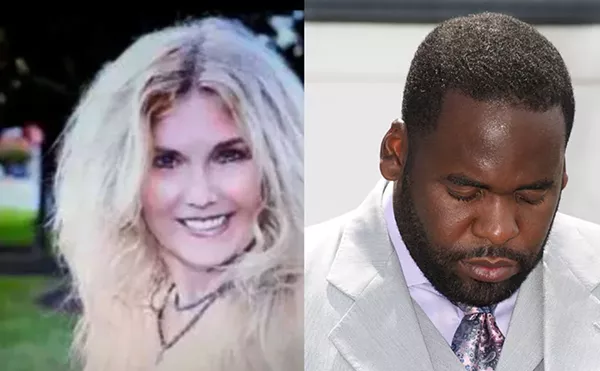
Audio By Carbonatix
[
{
"name": "GPT - Leaderboard - Inline - Content",
"component": "35519556",
"insertPoint": "5th",
"startingPoint": "3",
"requiredCountToDisplay": "3",
"maxInsertions": 100,
"adList": [
{
"adPreset": "LeaderboardInline"
}
]
}
]
Tragedy can be wallet-sized. Like a small photo stuck in the bottom of a billfold, it may be forgotten until the valuables of a life are emptied. And it can’t be picked and torn away from one’s consciousness.
Sy Parrish (Robin Williams, Insomnia) is One Hour Photo’s tragic antihero. Sy, “The Photo Guy,” as young Jakob Yorkin calls him with at least a touch of affection, takes “tragic” down to an even more mundane level than the titular salesman of Death of a Salesman. It’s a radically dramatic break from the plunging gods and other falling, larger-than-life protagonists who define the adjective.
Death — or at least its discernible shadow — is tragedy’s cadence. In this picture, it’s never actual but subtly psychological. Writer-director Mark Romanek captures it in the vast, statically arranged emptiness of Nina Yorkin (Connie Nielsen, Mission to Mars) and her husband Will’s (Michael Varkin, TV’s “Alias”) master bedroom. He does the same in the still life of Sy Parrish, who lays himself out on a hotel bed like a dead man for viewing after he has set up and framed his bloodless-yet-chilling revenge.
Romanek only spills blood in Sy’s horrifying nightmare — and that blood is Sy’s own, belying Photo’s marketing. Sy isn’t a psycho killer. He’s a psycho who would be a hero. The Photo Guy attempts to protect the perfect family of his daydreams and delusions, Nina and her 9-year-old son Jakob, from husband-and-father Will after he falls from the grace of Sy’s fantasies. Sy literally sees Will’s sins against his family and damns him for them, and (less consciously) for unknowingly refusing to play the idealized role he’s been assigned in the hyperreal photo-album playhouse of Sy’s sick mind. The SavMart one-hour photo lab manager’s retributions are aptly photographic.
If he could, Sy would just take his “family” and go home. But just as the Yorkins are not his real family, the numbing neutrality of his apartment is not a real home. Sy’s space is barely of this Earth. It vaguely recalls the sterile, zoolike cell the astronaut found himself sentenced to life in during the final reel of 2001: A Space Odyssey. Here, it’s as if the aliens have come closer to creating a simulacrum of the human habitat — but a color-blind one.
Sy is an alien in his own world. Alone, the masklike face that he attempts to work while in front of others switches off, inactive. In his high-tech photographic minilab, he’s an odd Wizard of Oz developing two-dimensional fetishes of happiness that he delivers to his customers with a “say cheese” smile. (Sy’s face only relaxes into a rare natural smile in the stolen moments he spends “with” his “family.”) He’s hypersensitive to color, which may explain both the lack of color in his living quarters and his given name, Seymour. Subtle shifts in the hue and tint of a print, usually only detectable by diagnostic equipment, offend his professional pride. Donning a filter mask and oversized black rubber gloves to dispose of exhausted chemicals, he’s a picture of alienation.
But Romanek takes him beyond alienation into abjection: where blinding psychological trauma triggers a sequence of self-destruction. Sy is so self-effaced that he’s become a chameleon, virtually vanishing into his beige-and-bone walls and the blue-and-white SavMart aisles. He comes out of the tree trunks in a suburban park as he approaches Jakob with his typical benign oddity that ironically has shades of threat and of the threatened.
Williams’ tour-de-force performance recalls a piece of minimalist music, where the shift of one note in a pattern becomes a seismic occurrence. When Sy’s face contorts to vent a lifetime of repressed rage, it’s an emotional earthquake.
The only thing that mars the finish of this film is the flat melodrama of the Yorkins’ dysfunctional marriage. Nina and Will’s characters seem almost as empty as Sy’s fantasy of them.
Sy believes that unless one is photographed, they’ve no proof of existence, of being alive. He snaps a picture of himself with Nina’s Leica to finish off her roll of film. Why waste a shot, he says. Romanek certainly doesn’t — and he’s made One Hour Photo unforgettable.
James Keith La Croix writes about film for Metro Times. Send comments to letters@metrotimes.com.





